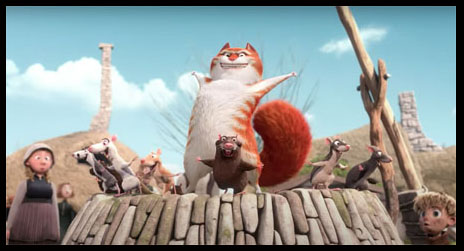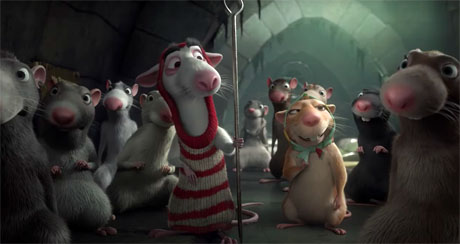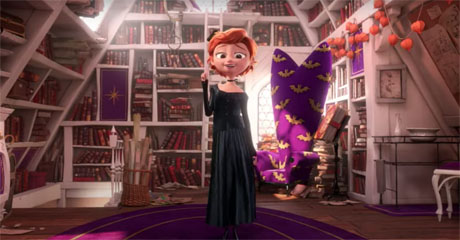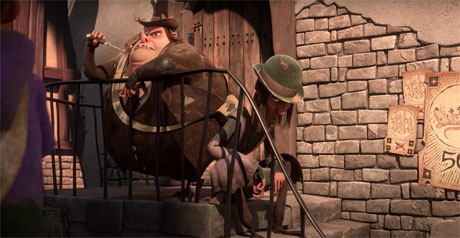
Toby Genkel is the director of The Amazing Maurice, a new animated comedy adventure coming to theaters nationwide on February 3rd via Viva Kids. It’s based on the late Terry Pratchett’s beloved book and features the voices of Hugh Laurie, Emilia Clarke, Hugh Bonneville and Himesh Patel. Ahead of the film’s Sundance Film Festival screening this Sunday Jan. 22, I spoke with Genkel about the amazing production of The Amazing Maurice. (This Animation Scoop Q&A was edited for length and clarity.)
Jackson Murphy: It’s very cool that this is going to be at Sundance in-person starting this Sunday Jan. 22 and available to watch at home online, with virtual screenings, from the 24th to the 30th. How does it feel to have this be a part of one of the biggest film festivals in the world?
Toby Genkel: Almost surreal to be honest. Really exciting. Really honored and really pleased. We couldn’t believe it in the first place because I was told it’s very hard to get an animation film into Sundance, but here we are!

JM: And I also have to congratulate you on the BAFTA longlist recognition for the film. It’s one of the eight finalists for the Best Animated Film BAFTA. That’s a huge honor.
TG: I don’t know what to say. It’s surreal… and a very nice kind of pressure that we feel there. The movie is made — there’s no more pressure on us. It’s being excited and [wondering] how the people will react. So far they’ve reacted very nicely. So we’re very pleased and honored.
JM: I really enjoyed the film. It’s based on the late Terry Prachett’s 2001 book. There’s a mischievous cat teaming-up with some human and animal friends. They get to a town with food, rat and villain problems. What really inspired you to get into the world of this story?

Toby Genke
JM: (laughs) You succeed with it so well. Maurice is truly unlike any cinematic animated cat I’ve ever seen. His vibe, edge, attitude and slick confidence… how did you want to approach presenting Maurice to audiences who may not be familiar with this character?
TG: Well, when reading the script and the book, we realized these are very original characters. You have not seen them exactly. Again, it’s an honor to Pratchett and Rossio. When you read the script, you can’t wait to get them on screen. I really tried to keep them as original as we possibly could. Don’t change it. Why change them if they’re perfect? When I started reading the novel and what has to be in the film, I started marking lines on pages… and you end up marking pages and pages and pages because it’s so good! And you realize, “We have to lose stuff because we cannot do it all.” Then you hope you choose the right stuff. But because every line is so great, it’s always the right choice to make, isn’t it? (laughs) It makes it very easy, though it really is not. We were really standing on the shoulder of a giant, Terry Pratchett. We kept the spirit of him and tried somehow to get it on screen. Maurice is quite sarcastic and mean.

JM: And unpredictable for sure.
TG: Absolutely unpredictable. He does not respect the rats. And then boy does he come around! It’s a gift from Heaven having such a full circle character there. It’s really well done.
JM: And Hugh Laurie is terrific. We’ve heard him in “Arthur Christmas”, “Monsters vs. Aliens” and “Stuart Little”. He’s one of the most talented British voice actors.
TG: Forgive me, I’m lacking the words to describe how cool Hugh Laurie is. I was such an admirer and a fan since the beginning. Hugh Laurie was part of the original character briefing that I wrote probably three years ago, to give it to the first character designer. “Who is Maurice?” I described it as, “There’s a lot of Dr. House in Maurice.” Nobody’s playing this aloof arrogance like him. But there’s always some undertone to it that makes you love him anyway, which is a very delicate thing to make. Great job from the casting to get him on board.
JM: And from the get-go, the film has a great self-aware nature, with the story within the story and how it [exists]. Tell me about what you wanted to do as far as getting us into it and presenting the self-aware beats we have as the movie goes on.
TG: This is how Malicia was designed by Terry Pratchett. She is really quite close to the novel. She’s really self-aware about the storytelling. And she’s such a cool character! It’s not that easy. Don’t try this at home, I have to say. And as filmmakers we enjoy it, the film in a film kind of idea. But that said, it’s a delicate thing to make. You have to be careful. People could get quite easily annoyed by it. It’s an ongoing inside joke, and the audience can feel excluded by it. And what Pratchett and Rossio did so well is: this is something that drives the story. Her love for story is what drives the story. We don’t do it for the sake of doing it. It’s a key momentum of the story — the story in a story idea. It’s fun and everybody accepts it as a motor.

JM: You have a lot of fun with it. It will open-up kids and parents’ minds to how you can twist-up fairy tales in this sort of way. And Malicia also has the best giant purple chair!
TG: (laughs)
JM: Part of what you do with the structure of the movie and the inside references is you have some bold jabs at “Peter Rabbit”. They’re very funny.
TG: Thank you, but they’re also part of the original book, referring to Beatrix Potter. The illustrations are very old, and we thought this is probably what we refer to. They give you a weird little part of the framing device because they don’t tell you exactly where the story goes — it’s quite mysterious and ominous in a very funny way. We went overly cute and tried to sugarcoat sugar. (laughs) There’s the wink there, the way Terry Pratchett used these. And the rats believe this, and we, as the audience, know it might not be real. But that’s exactly the point. They have to learn in a very painful way.
JM: Right. And those sequences are hand-drawn. So was it interesting for you to oversee CG production and hand-drawn production?
TG: It was awesome to mix those styles. And we didn’t mix styles for the sake of it. I did 2D in the past… and it just had to be this way. The style was set by the story. And it was great to open the film in a completely different style. In the first couple of minutes, we get (as we call it) three different slaps in the face. We have the fade in, which is 2D and over-romantic, beyond Disney sweet. And then suddenly it goes “Boom!” and we’re in a 3D world in this weird room with this girl who’s talking a lot. And then suddenly, “Boom!” we get Hugh Laurie [as Maurice]. We were sure of one thing: we have people’s attention. (laughs)
JM: Yes! You had my attention right from the get-go.
TG: Oh that’s good!

JM: We go to so many different locations, indoors and outdoors, including the sewer system and an old-fashioned town. What was key in making the locations work for the story and the characters?
TG: It always comes from the script — “Who are these characters?” And this will define what the locations are. Basically we did this for everything. Look at Malicia’s room. She’s a bookworm. She’s reading so much that she’s locked OUT of her room. This is crazy, so it must somehow be a crazy room in the attic. And basically the room is made of books. And one thing came to the next. And because she’s narrating so much, we said we cannot have her just sit in this chair and read. It might get boring. So we decided there must be more options there. It all started adding up. When it comes to the sewers, as the movie goes on, the problems get bigger and heavier for the rats, and everything tightens around them. The sewers get smaller, tighter, narrower and darker as the movie moves on. We always use this as a language to visualize the problem of the rats.
JM: What do you think makes a good hero in animated films and cinematic storytelling? A big theme of this film is what it means to be a hero. What does it mean to you as a storyteller of animated films?
TG: Well, thank God, or thank Heavens… thankfully, there are many kinds of heroes. We don’t have to decide on one. We can share a new one on every film. I think that’s very important. I don’t really have a favorite kind of hero. But… the real hero in this film is Keith.
JM: Right, our sort of ‘pied piper’.
TG: In the book I think he’s called ‘a stupid-looking kid’. And he really isn’t because you are totally underestimating him and what he can do. And how he’s rising to the occasion. This is the kind of hero I like best. He needs a little nudge. But here’s the thing: he always says he doesn’t want to go along and he feels like he’s a coward. But what does is: he goes along and faces every danger. He’s scared all the time but he does it anyway. And isn’t that what heroism means? You can be afraid, but it doesn’t stop you. And in the end… I like that it isn’t about violence. There’s another solution, and we worked very hard to get that across.
JM: I think families will invest themselves in this. What’s interesting is that Viva Pictures and Viva Kids are releasing this in North America on February 3rd, during a time when there are not a lot of genuine family or animated movies that are going to be released in theaters. This is a fantastic option. What does it mean to you to kind of be serving this need?
TG: Thank you for saying that this movie is different. I find it hard to judge my own work. And of course, I’m speaking on behalf of a great team. I’m just the herald here. I’m just representing awesome people. If we have managed to make a film that is special, then I’m more than happy. And I hope we did. We hope you’re right. We hope to find a broad audience.
- INTERVIEW: Jeff Fowler On “Knuckles” And “Sonic 3” - April 22, 2024
- INTERVIEW: “Inside Out 2” Director And Producer On Pixar Sequel - April 16, 2024
- INTERVIEW: “Puffin Rock And The New Friends” And 25 Years Of Cartoon Saloon - April 10, 2024


 January 18th, 2023
January 18th, 2023  Jackson Murphy
Jackson Murphy  Posted in
Posted in  Tags:
Tags: 






